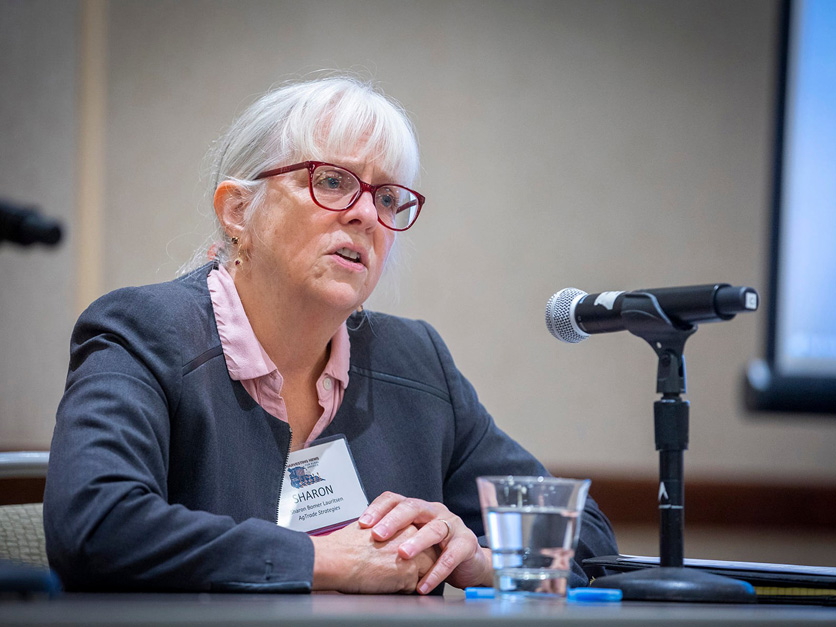The Biden administration has all but ruled out tariff-slashing market access deals when it comes to its proposed Indo-Pacific Economic Framework, but the U.S. ag sector still hopes the agreement will include a trade pillar that boosts exports to rapidly growing markets that are home to a patchwork of regulatory restrictions and non-tariff trade barriers.
Overly complex registration systems in the region are stymieing U.S. dairy exports, outdated disease protections are holding back U.S. meat sales, and unscientific biotechnology approval processes are slowing grain trade, according to U.S. farm groups that are petitioning the Office of the U.S. Trade Representative to focus on removing those barriers as the Biden administration negotiates the framework, now commonly known as IPEF.
The framework was the primary topic when U.S. Trade Representative Katherine Tai and Agriculture Secretary Tom Vilsack met last week at USDA headquarters with some of the most influential ag leaders in the country, according to sources who asked not to be identified. The two cabinet members were adamant in two one-hour meetings with industry leaders that tariff-slashing market access deals — the kind made in free trade agreements to boost U.S. ag exports — will not be a part of IPEF.
But Tai and Vilsack were also clear that non-tariff trade barriers would be targeted as part of the effort to strengthen ties in the region, which is creating some optimism that U.S. ag trade could reap significant benefits.
 Sharon Bomer Lauritsen
Sharon Bomer Lauritsen
“Whenever the U.S. engages in negotiations, the negotiators always try to resolve unwarranted trade barriers,” said Sharon Bomer Lauritsen, founder of AgTrade Strategies LLC, who was not in the meetings. “I fully expect with IPEF that USTR and USDA will make every effort to address real barriers to exports.”
While the messages from Tai and Vilsack that the most traditional forms of new market access deals aren’t on the table were not generally well-received, farm groups are already submitting detailed proposals on which international non-tariff barriers they want to see removed during IPEF negotiations.
There are plenty of non-tariff trade barriers in countries like Vietnam, Indonesia, Malaysia, Mongolia, New Zealand, Singapore, Taiwan, and Thailand that U.S. farm groups like the U.S. Grains Council, the U.S. Dairy Export Council and U.S. Wheat Associates hope will be addressed in IPEF negotiations.
“Across the Asia-Pacific region, U.S. red meat exports face a litany of non-science-based barriers to trade that prevent the U.S. industry from reaching its full export potential. Korea, Japan, Taiwan, Singapore and Australia still maintain outdated barriers to U.S. beef exports related to the 2003 Bovine Spongiform Encephalopathy (BSE) case in the U.S.,” the U.S. Meat Export Federation says in IPEF comments submitted to USTR.
“The Asia-Pacific region is the most important market for U.S. red meat exports. Not only does the U.S. industry depend on large volume, high-value markets such as Japan, South Korea, and China, but also sees tremendous growth opportunities in Southeast Asia.”
Whereas the U.S. has more than a 30% share of the imported beef and pork markets in Japan and South Korea, the percentages in other countries such as the Philippines and Vietnam are much lower. The U.S. market share for imported beef in Indonesia is just 9%, according to USMEF. It’s even lower in the Philippines and Vietnam — 6% and 3%, respectively — and the pork numbers are similar. The U.S. provides just 15% of the Philippines pork imports, 7% of Indonesia’s pork imports and a mere 2% of Vietnam’s pork imports.
While the U.S. market shares are still small is some Asian countries, USMEF says, growth is strong despite tariff and nontariff barriers.
Vietnam’s trade barriers are particularly vexing for the U.S. grain sector, according to IPEF comments submitted by both the U.S. Wheat Associates and the U.S. Grains Council.
Looking for the best, most comprehensive and balanced news source in agriculture? Our Agri-Pulse editors don't miss a beat! Sign up for a free month-long subscription.
“Vietnam continues to consider bans on common agricultural pesticides without conducting appropriate risk assessments as well as restrictions on Canadian thistle seeds, common grain insects and ergot,” which is a fungal disease, USW says. “Trade is currently occurring through aggressive cleaning of U.S. wheat supplies, but U.S. exporters continue to face the threat of potential re-export in the event of Canadian thistle seed detections at destination.”
The U.S. only supplies about 10% of Vietnam’s wheat imports, but USW says that could be much higher “upon the resolution of [sanitary and phytosanitary] barriers that would provide a more certain atmosphere for trade.”
The Grains Council says it is particularly hopeful that IPEF negotiations can be a means to increase congruence in the processes Indo-Pacific countries use to approve genetically modified plant traits.
“Unfortunately, regulatory uncertainty continues to stymie the free flow of biotech grain into certain countries in the Indo-Pacific Region,” said USGC in its IPEF submission to the USTR. “There are currently numerous impediments for biotech crops including: asynchronous approvals that create backlogs of unapproved traits, evaluation procedures not based on international scientific standards, unnecessary testing, labeling (and) traceability requirements, and even outright bans on genetically modified products.”
The chance to reduce trade barriers in the region is significant for the U.S. dairy industry, says Jaime Castaneda, executive vice president of the National Milk Producers Federation and the U.S. Dairy Export Council, although he remains insistent that tariff-reducing deals are also key for U.S. international competitiveness.
“The Asian-Pacific region is already one of the largest dairy export destinations and it offers even greater promise in the years to come,” Castaneda told Agri-Pulse. “For U.S. dairy exporters to realize those opportunities though, we need to play catch-up in the region against our key competitors in the EU and Oceania that have been really busy negotiating tariff and non-tariff advantages for themselves through their own trade agreements with the region.”
 Jaime Castaneda, USDEC
Jaime Castaneda, USDEC
One major obstacle Castaneda pointed out is the difficulties U.S. companies have in getting their dairy facilities registered to export to Southeast Asian countries.
“We have many companies that have been waiting over two years at this point just for the chance to have their applications reviewed in countries in (Southeast Asia),” he said. “That’s not sustainable and needs fixed.”
One potential disappointment for U.S. farm groups may be the partial exclusion of India — a country with significant barriers that complicate trade. Sources tell Agri-Pulse that government officials are warning that while India will be a major participant in IPEF, it may not be included in the trade pillar because of high U.S. participation demands when it comes to labor and environmental standards.
Bomer Lauritsen, a former assistant U.S. trade representative for agricultural affairs and commodity policy, noted that the strength of IPEF will depend on how many countries join that don’t already have trade agreements with the U.S. That would mean getting nations like Indonesia, India and Vietnam to join.
For more news, go to www.Agri-Pulse.com.


